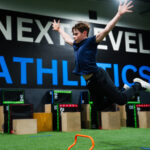Speed and Agility Training for Reaction Time
Speed and agility training isn’t just about moving fast—it’s about reacting fast. In nearly every sport, the difference between winning and losing often comes down to milliseconds. How quickly you process a stimulus and make a move determines how effective you are under pressure.
While traditional speed and agility training focuses on movement, adding reaction-based elements turns your workouts into brain and body boosters. This article explores how to train for quicker reflexes, better focus, and faster reaction time through agility drills that challenge both mind and muscle.
Why Reaction Time Matters in Sports
Speed gets you moving. Agility helps you change direction. But reaction time helps you decide when and how to move.
Every sport has split-second decisions:
-
A soccer player sees a defender shift and reacts with a cut.
-
A quarterback reads a blitz and scrambles.
-
A tennis player responds to a serve before the ball crosses the net.
All these moments rely on fast processing, not just fast feet. If you train only your body and ignore your reaction speed, you’re leaving performance on the table.
How Speed and Agility Improve Mental Performance
High-level movement training enhances:
1. Neural Efficiency
Agility drills with reaction elements force your brain to send quicker, clearer messages to your body. This sharpens motor pathways.
2. Focus and Attention
Multi-tasking drills force athletes to stay alert, track cues, and maintain posture. This builds mental resilience.
3. Pattern Recognition
Regularly responding to visual or auditory cues boosts your ability to recognize movement patterns—crucial for competitive sports.
4. Hand-Eye Coordination
Many agility drills can be done with balls, light cues, or colored markers. These improve coordination and reaction at once.
According to Healthline, physical activity increases cognitive function, improves memory, and sharpens focus—all vital for athletes.
Unique Drills to Boost Reaction Time and Agility
These drills integrate reactive elements with traditional speed and agility training. They’re simple, effective, and scalable for all ages.
1. Mirror Drill
Setup: Stand 5 feet apart from a partner
Execution: One athlete leads with lateral movements, cuts, or sprints while the other mirrors their movements
Focus: Decision-making and reactive footwork
Sets: 4 sets of 30 seconds
2. Color Cone Callout
Setup: Place cones of various colors randomly spaced
Execution: Coach calls a color. Athlete sprints, shuffles, or crawls to the matching cone
Focus: Visual recognition and reaction
Sets: 5–6 color changes per round
3. Ball Drop Sprint
Setup: Partner stands on a box holding a tennis ball
Execution: When they drop it, athlete must sprint and catch it before the second bounce
Focus: Explosiveness and reaction
Sets: 3–5 reps per side
4. Agility Ladder + Command Drill
Setup: Ladder on the ground
Execution: While performing a ladder drill, coach gives a random command (“Jump,” “Turn left,” “Sprint”)
Focus: Processing commands mid-movement
Tip: Use a whistle or hand signal for non-verbal commands
5. Flash Reflex Lights or Apps
Setup: Use reaction light tools or mobile apps like FitLight or BlazePod
Execution: Tap the lights as they flash in random patterns
Focus: Visual reaction speed and coordination
Sets: 3 rounds of 20–30 seconds
Weekly Reaction-Based Speed and Agility Training Plan
A sample week to integrate reaction-based drills into a full speed and agility routine:
Monday – Reaction + Agility Combo
-
Warm-up jog + dynamic stretches
-
Ladder footwork + command cues – 3 sets
-
Mirror drill – 3 sets of 30 seconds
-
Core finish: Bird dogs + dead bugs
Wednesday – Visual Stimulus Day
-
Ball drop sprint – 5 reps
-
Cone color callout – 3 rounds
-
Flash light drills (or app version) – 2 rounds
-
Sprint relay with random start cues – 4 sets
Friday – Reactive Movement Integration
-
Ladder shuffle + “Go!” call sprint – 3 sets
-
Partner tennis ball reaction toss – 3 sets
-
Mirror + sprint finish – 2 sets
-
Cool down jog + stretch
Tips to Maximize Results
-
Start Slow, Then Add Speed: Reaction drills require good form. Master the basics first.
-
Use Random Cues: Avoid predictable commands. The goal is to train real-time decision-making.
-
Limit Drill Time: High-focus reaction work is mentally taxing. Quality > quantity.
-
Mix Modalities: Use both visual (light, color) and auditory (clap, whistle) cues to develop complete reactivity.
-
Track Improvements: Record drill completion times or reaction scores over weeks.
Who Should Use Reaction-Based Agility Training?
These drills work for all athletes, but they are especially powerful for:
-
Quarterbacks, point guards, and soccer midfielders who need elite field awareness
-
Goalkeepers and defenders who must react to sudden changes
-
Combat sport athletes like boxers and wrestlers, where timing is everything
-
Youth athletes building coordination and processing ability
The earlier these skills are developed, the better they transfer to in-game decisions and success.
Train Smart, Train Sharp
At Next Level Athletics USA, we help athletes level up both physically and mentally. Our performance programs combine cutting-edge agility training with reaction drills to create smarter, faster competitors. If you’re ready to master game-speed decisions, check out our sessions.
Final Thoughts
Speed and agility training for reaction time takes your athleticism to the next level. It goes beyond fast feet—it’s about fast thinking and precise decisions.
By blending physical drills with mental challenges, you’ll improve your timing, awareness, and performance under pressure. Athletes who react faster play faster—and win more.
Train your brain like you train your body. The results will speak for themselves.


Recent Comments